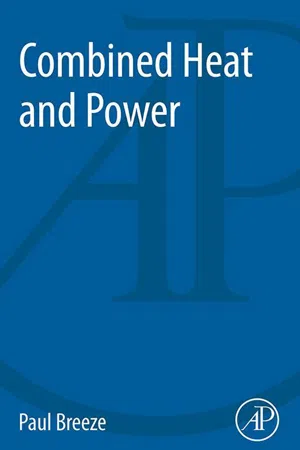Chapter 1
An Introduction to Combined Heat and Power
Abstract
Much of the electricity consumed on the earth is produced by converting combustion heat into electrical energy via the use of heat engines. These engines can achieve at best 60% efficiency which means that at least 40% of the heat generated by burning fuel, and often much more, is wasted. A combined heat and power (CHP) system aims to use this heat either in an industrial process or for space heating and hot water. One of the main applications is for district heating. Some industries, such as paper manufacturing, can also make good use industrial CHP facilities. The adoption of CHP varies widely from country to country. It is popular in Europe and the USA has a relatively large CHP capacity, as does Russia. The most common fuel for CHP plants is natural gas.
Keywords
Combined heat and power; CHP; district heating and cooling; district heating; process heat; natural gas; biomass; nuclear CHP; heat engine
Much of the electricity that is generated on our planet is produced using heat engines that convert heat into electrical power. The heat for these heat engines comes from a variety of sources. Most is produced through the combustion of fossil fuels in steam plants, gas turbines plants, and reciprocating engines. Energy in nuclear power plants is also released in the form of heat which is used to drive a heat engine, usually a steam turbine, while biomass is often burned, too, to release heat.
The production of electricity in these plants from coal, oil, gas, and biomass is an inefficient process. While some modern combustion plants can achieve 60% energy conversion efficiency, most operate closer to 30% and smaller or older units may reach only 20%. The USA, which has a typical developed-world mix of fossil fuel based combustion plants, achieves an average fuel-to-end-user power plant efficiency of 33%, a level that has barely shifted for the past 30 years. Other countries would probably struggle to reach even this level of efficiency. Nuclear power plants are relatively inefficient too, with typical efficiencies of around 33%.
Putting this another way, between 40% and more than 80% of all the energy released in thermal power plants is wasted. The wasted energy emerges as heat which is dumped in one way or another. Sometimes, it ends up in cooling water which has passed through a power plant and then returned to a river or the sea, but most often it is dissipated into the atmosphere through a heat-exchanger. This heat can be considered a form of pollution.
Efficiency improvements can clearly curtail a part of this loss. A plant that has an efficiency of 60% will dump 40% less heat than a power station that achieves only 30% fuel-to-electrical efficiency. But even with the most efficient energy conversion system, a significant loss of energy is inevitable. Neither thermodynamic nor electrochemical energy conversion processes can operate even theoretically at anywhere near 100% efficiency and practical conversion efficiencies are always below the theoretical limit. So while technological advances may improve conversion efficiencies, a considerable amount of energy will always be wasted.
While this energy cannot be utilized to generate electricity, it can still be employed. Low grade heat can be used to produce hot water or for space heating,1 while higher grade heat will generate steam which can be exploited by some industrial processes. In this way, the waste heat from power generation can replace heat or steam produced from a high value energy source such as gas, oil, or even electricity. This represents a significant improvement in overall energy efficiency.
Systems which utilize waste heat in this way are called combined heat and power or CHP systems. The term cogeneration is often used too while district heating and cooling (DHC) uses essentially the same technologies. Such systems can operate with an energy efficiency of up to 90% when heat usage is taken into account. This represents a major saving in fuel cost and in overall environmental degradation. Yet while the benefits are widely recognized, the implementation of CHP remains low.
Part of the problem lies in the historical and widespread preference for large central power stations to generate electricity. Large plants are efficient, and they are normally built close to the main transmission system so that power can be delivered into the network easily. They may also be sited close to a source of fuel. This will often mean that they are far from consumers that can make use of their waste heat.
If central power plants are built in or near cities and towns then they can supply heat as well as power by using their waste heat in district heating systems. Municipal utilities in some European and US cities have in the past built power plants within the cities they serve in order to exploit this market for heat as well as power but it is not an approach that has been widely adopted and environmental considerations makes building large power plants in cities more difficult today. There are also many examples of power plants being built close to industrial centers such that they can provide high grade steam for industrial use. In the main, however, large fossil fuel power plants simply waste a large part of the energy they rel...
